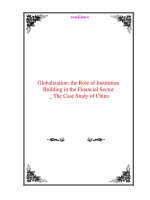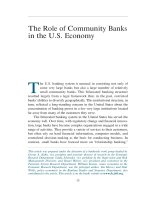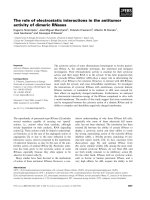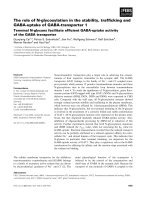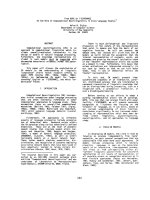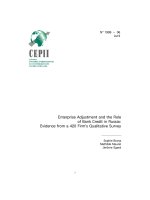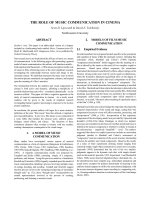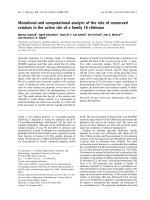THE ROLE OF PENSION FUNDS IN FINANCING GREEN GROWTH INITIATIVES potx
Bạn đang xem bản rút gọn của tài liệu. Xem và tải ngay bản đầy đủ của tài liệu tại đây (1.61 MB, 70 trang )
Please cite this paper as:
Della Croce, R., C. Kaminker and F. Stewart (2011).
“The Role of Pension Funds in Financing Green Growth
Initiatives”, OECD Publishing, Paris.
OECD WORKING PAPERS ON FINANCE, INSURANCE
AND PRIVATE PENSIONS, NO. 10
By Raffaele Della Croce, Christopher Kaminker and
Fiona Stewart
THE ROLE OF PENSION
FUNDS IN FINANCING
GREEN GROWTH
INITIATIVES
September 2011
2
OECD WORKING PAPERS ON FINANCE, INSURANCE AND PRIVATE PENSIONS
OECD Working Papers on Finance, Insurance and Private Pensions provide timely analysis and
background on industry developments, structural issues, and public policy in the financial sector,
including insurance and private pensions. Topics include risk management, governance,
investments, benefit protection, and financial education. These studies are prepared for
dissemination in order to stimulate wider discussion and further analysis and obtain feedback
from interested audiences.
The papers are generally available only in their original language English or French with a
summary in the other if available.
OECD WORKING PAPERS ON FINANCE,
INSURANCE AND PRIVATE PENSIONS
are published on www.oecd.org/daf/fin/wp
© OECD 2011
Applications for permission to reproduce or translate all or part of this material should be made to:
OECD Publishing, or by fax 33 1 45 24 99 30.
3
Abstract/Résumé
THE ROLE OF PENSION FUNDS IN FINANCING GREEN GROWTH INITIATIVES
Abstract: It is estimated that transitioning to a low-carbon, and climate resilient economy, and more
broadly „greening growth‟ over the next 20 years to 2030 will require significant investment and
consequently private sources of capital on a much larger scale than previously. With their USD 28 trillion
in assets, pension funds - along with other institutional investors - potentially have an important role to
play in financing such green growth initiatives.
Green projects - particularly sustainable energy sources and clean technology - include multiple
technologies, at different stages of maturity, and require different types of financing vehicle. Most pension
funds are more interested in lower risk investments which provide a steady, inflation adjusted income
stream - with green bonds consequently gaining interest as an asset class, particularly - though not only -
with the SRI universe of institutional investors.
Yet, despite the interest in these instruments, pension funds‟ asset allocation to such green
investments remains low. This is partly due to a lack of environmental policy support, but other barriers to
investment include a lack of appropriate investment vehicles and market liquidity, scale issues, regulatory
disincentives and lack of knowledge, track record and expertise among pension funds about these
investments and their associated risks. To tap into this source of capital, governments have a role to play in
ensuring that attractive opportunities and instruments are available to pension funds and institutional
investors.
This paper examines some of the initiatives that are currently under way around the world to assist
and encourage pension funds to help finance green growth projects. It is drafted with a view to inform
current OECD work on engaging the private sector in financing green growth. Different financing
mechanisms are outlined, and suggestions made as to what role governments in general, and pension fund
regulatory and supervisory authorities in particular, can play in supporting pension funds investment in this
sector. The paper concludes with the following policy recommendations: provide supportive environmental
policy backdrop; create right investment vehicles and foster liquid markets; support investment in green
infrastructure; remove investment barriers; provide education and guidance to investors; improve pension
fund governance.
JEL codes: G15, G18, G23, G28, J26
Keywords: pension funds, green bonds, infrastructure, green growth
4
THE ROLE OF PENSION FUNDS IN FINANCING GREEN GROWTH INITIATIVES
By Raffaele Della Croce, Christopher Kaminker and Fiona Stewart
*
TABLE OF CONTENTS
EXECUTIVE SUMMARY 6
THE ROLE OF PENSION FUNDS IN FINANCING GREEN GROWTH INITIATIVES 8
I. Green Growth Financing Requirements 8
II. Potential Role of Pension Funds in Green Investment 11
III. Barriers to Green Investing + Potential Solutions 18
Problems with Green Investment Policy Backdrop 18
IV. Pension fund initiatives in green investing 30
Type of Investors 30
Size of Assets 30
Objectives 30
IIGCC 30
Investor Network on Climate Risk (managed by Ceres) 30
Investor Group on Climate Change 30
Australian and New Zealand investors 30
Long-term Investors Group 30
P8 Group 32
Other Groups 32
*
This working paper was prepared by Raffaele Della Croce, Christopher Kaminker and Fiona Stewart from the
OECD‟s Directorate for Financial and Enterprise Affairs and Environment Directorate. Though drawing on
OECD Council approved recommendations and other work supported by OECD committees, the views
expressed herein are those of the authors and do not necessarily reflect those of the OECD or the
government of its Member countries.
The authors would like to thank Simon Upton, Helen Mountford, Jan Corfee-Morlot, Michael Molitor, Marie-
Christine Tremblay, Celine Kauffman and all their OECD colleagues who provided valuable comments
and input into the paper. Input and comments from the following experts was also most appreciated: Ben
Caldecott (Head of European Policy, Climate Change Capital); Aled Jones (Global Sustainability Institute,
Anglia Ruskin University); Sean Kidney (Climate Bonds Initiative); Frederic Ottesen, (Chief Investment
Officer, Storebrand); Brian A. Rice (Investment Officer, California State Teachers' Retirement System);
Richard Robb (Professor in the Professional Practice of International Finance, Columbia University);
Shally Venugopal (World Resources Institute); Simon Zadek (Senior Visiting Fellow, Global Green
Growth Institute), Ingrid Holmes (E3G).
5
V. Vehicles of Green Investing for Pension funds 36
Green Bonds 36
Structured Green Products 48
Green Infrastructure Funds 53
Other Initiatives 59
VI. Policy Recommendations 61
Drive Enabling Environmental Policy Backdrop 61
Create Right Investment Vehicles and Increase Market Liquidity 61
Support Investment in Green Infrastructure 62
Remove Investment Barriers 63
Education and Guidance 64
Improve Pension Fund Governance 64
BIBLOGRAPHY 66
WORKING PAPERS PUBLISHED TO DATE 69
BOXES
Examples of Regulatory Support for Renewable Energy 21
Mechanisms for Leveraging Private Finance 24
Build America Bonds 47
Case Study - CRC Breeze Finance Bonds 49
Case Study - Andromeda Finance Srl 52
Green Banks 60
6
EXECUTIVE SUMMARY
It is estimated that transitioning to a low-carbon and climate resilient economy and more broadly
„greening growth‟ over the next 20 years will require significant investment and consequently private
sources of capital on a much larger scale than previously - particularly given the current state of
government finances. There is already international agreement on the need to increase financing for
climate mitigation and adaptation – with international financing commitments already having been made.
With their USD 28 trillion in assets, pension funds – along with other institutional investors – potentially
have an important role to play in financing such green growth initiatives.
Green projects – particularly sustainable energy sources and clean technology - include multiple
technologies, at different stages of maturity (from new technologies to those already deployed on a large
scale), requiring different types of financing vehicle. Institutional investors can access such projects via
equity (including indices and mutual funds), fixed income (notably green bonds) and alternative
investments (such as direct investment via private equity or through green infrastructure funds). Most
pension funds are more interested in lower risk investments which provide a steady, inflation adjusted
income stream – with green bonds consequently gaining interest as an asset class, particularly – though not
only - with the Socially Responsible Investment (SRI) universe of institutional investors. Yet, despite the
interest in these instruments, pension funds‟ asset allocation to such green investments remains low (less
than 1%), due to a number of factors.
The key to increasing pension funds‟ allocation to this space is to make sure that green investments
are competitive on a risk return basis. In order to really leverage private capital, pension funds outside the
SRI space – which, though growing in importance, is still niche – will have to be tapped. Pension funds
and other institutional investors will not make an investment just because it is green – it also has to deliver
financially.
One important barrier to further investment by pension funds is the unsupportive environmental
policy backdrop. Most green investments are currently uncompetitive, partly as they often involve new
technologies which require support and have yet to be commercialised. However, they are also
uncompetitive due to market failures – with existing, „black‟ technologies mispriced due to pollution
externalities not being accounted for and fossil fuels still being heavily subsidized.
Government policies are therefore needed to support the commercialisation of new technologies
(R&D tax credits; accelerated depreciation; investment incentives; government support for venture capital
funds; and output-stage support such as feed-in tariffs etc.) and to correct market failures through carbon
pricing). To create this type of „investment grade‟ policy, such support needs to be „loud‟ (big enough to
impact the bottom line), „long‟ (for a sustained period) and „legal‟ (with regulatory frameworks clearly
established).
Another key barrier is the lack of financial instruments enabling pension funds to make these
investments. The market for green investments remains small and illiquid and there is often a mismatch
been pension funds‟ long-term, relatively low risk needs and the financing vehicles available. Governments
can again play a role to stimulate and develop the market – ensuring that adequate, investment grade-deals
at scale come to the market for pension funds to invest in. For financial vehicles specializing in early-stage
projects, public finance could invest alongside private capital, or institutional investors could take on
subordinated equity positions, with public funds taking on the first tranche of risk. Alternatively,
government bodies could provide loan guarantees. In addition governments and/or multinational agencies
can use so-called „Public Financing Mechanisms‟ to provide cover for risks which are new to pension
funds or cannot be covered in existing markets (such a political risk, currency risk, regulatory and policy
risk etc.). Standardizing and rating green investments would also help.
7
Though still small – a market for green investments is also starting to grow. Alongside more
developed equity products (such as green indices comprising of listed companies operating in the green
space), fixed income instruments are also being launched – notably green bonds, for which the OECD
estimates that the market is now around USD 16 billion. Alongside the World Bank‟s USD 2.3 billion
issuance, other development banks have become involved (EIB, ADB) and the US government has
introduced interesting initiatives. Other more exotic green financial vehicles have also been launched –
with mixed success. Green infrastructure funds are also likely to be an important way for pension funds to
pool their resources and invest in a portfolio of green projects (thereby sharing scale, knowledge and
gaining diversification – all key issues for smaller funds which cannot invest directly). Another important
initiative being launched by several governments (including the UK, Australia and possibly the USA) are
Green Investment Banks – which will use public money and raise funds joint with the private sector to
invest in assets relevant for climate change solutions.
A further barrier to pension funds‟ investment in green projects is their lack of knowledge and
experience not only with „green‟ projects, but with infrastructure investments in general (which green
projects are often a subsector of) and the financing vehicles involved (such as private equity funds or
structured products). However, major pension funds around the world have been coming together in order
to raise awareness of the climate change issue and the opportunities presented and to encourage the
creation of financing vehicles which will allow them and their peers to get involved. Some of the major
funds leading the way include ATP (Denmark‟s largest pension fund), PGGM (the pension fund for the
Dutch healthcare sector), CalSTRS and CalPERS (the Californian public sector funds).
What can governments do to support and drive these initiatives further? The most important thing is
to provide clear and consistent environmental policies which will fix market failures and give institutional
investors the confidence to invest in green projects. Without these policies climate finance from the private
sector will not be forthcoming.
Governments need to ensure that adequate, investment-grade deals at scale come to the market in
order to be able to tap the potential pension funds cash. This could include taking subordinated equity or
debt positions, providing risk mitigation and issuing green bonds.
Support for infrastructure projects more generally is also required (as outlined in the OECD
Principles for Private Sector Investment in Infrastructure) – including long-term planning and a sound
regulatory environment supporting PPPs etc.
Inadvertent barriers to pension fund involvement may exist in terms of investment and solvency
regulations (such as asset limits, restrictions on illiquid or non-listed investments/ solvency and accounting
rules pushing funds into government bonds) – which should be reviewed.
Support for pension funds can also be given through data collection and education initiatives to
improve the knowledge of pension fund trustees
8
THE ROLE OF PENSION FUNDS IN FINANCING GREEN GROWTH INITIATIVES
1
I. Green Growth Financing Requirements
Transitioning to a low carbon and climate resilient economy, and more broadly „greening growth‟ will
require shifting significant amounts of capital from fossil fuels and resource-intensive and polluting
technologies to newer, clean technology and infrastructure. The appropriate investment landscape will also
need to be supported by policy to drive additional capital towards „greening‟ or accelerated phase-out of
long-lived black assets such as coal-fired power plants, refineries, buildings and energy infrastructure.
Green growth can be seen as a way to pursue economic growth and development while preventing
environmental degradation, biodiversity loss and unsustainable natural resource use. It aims at maximising
the chances of exploiting cleaner sources of growth, thereby leading to a more environmentally sustainable
growth model (see OECD 2010a). To do this it must catalyse investment, competition and innovation
which will underpin sustained growth and give rise to new economic opportunities. This is the path that the
OECD is advocating in its Green Growth Strategy, and energy policy needs to be developed as an integral
part of this overall green growth framework (for more see OECD Green Growth Study: Energy Sector
2011e).
Investing in infrastructure and innovation will be crucial for ensuring new sources of growth that
better reflect the full value to economic activity to society. OECD analysis shows that greener growth can
deliver important economic gains. These can be realised through enhanced resource productivity, reduced
waste and energy consumption, and from ensuring that natural resources are priced to reflect their true
value. For example, a 17% increase in the type of investment needed to deliver low-carbon energy systems
between now and 2050 would yield an estimated cumulative USD 112 trillion in fuel savings (IEA 2010a).
It is estimated that just adapting to and mitigating the effects of climate change over the next 20 years to
2030 will require significant investment. The exact amount of financing needed to address climate change
will depend on many factors, including the level of ambition of mitigation goals and adaptation objectives,
and the extent to which „correct‟ price signals or regulation are provided.
2
This report does not propose to enter the discussions on financing and investment levels that will be
needed to support green growth such as is done by the IEA (2010a) for the energy sector, but rather will
look at where required flows may come from and how financial instruments such as green bonds might be
used to shift flows to support green growth. However, for illustrative purposes it is useful to examine the
ranges of estimates that are quoted. Smil (2010b) suggests that the scale of the envisaged global transition
to non-fossil fuels is immense, approximately 20 times larger than the scale of the last historical energy
transition (fossil fuel use was about 425 Exajoules (EJ) in 2010, compared with 20 EJ for traditional
biomass in 1890).
Table 1 illustrates some of the financing and investment levels quoted for various purposes that would
fall under the umbrella of greening growth. Estimates vary widely, and one figure that is quoted by the UN
1
Although this report focuses on pension funds, it should be seen in the context of the OECD‟s broader work on
institutional investors. The OECD has recently launched a project on “Institutional Investors and Long
Term Investment”. As part of this project further studies will follow, including for the insurance sector.
See www.oecd.org/finance/lti
2
See OECD note on „Financing Climate Change Action and Boosting Technology Change: Key messages and
recommendations from current OECD work‟
9
is USD 1.6 trillion per year in total
3
investment required for a global energy transformation that
simultaneously meets emission targets and facilitates an upward convergence of energy usages of
developing and developed countries. Additionally, the IEA (2010a) calculates that the decarbonisation of
the power sector will require additional investments of USD 9.3 trillion from 2010 to 2050 and the UN
(2011a) estimates global replacement costs of existing fossil fuel and nuclear power infrastructure at, at
least, 15 trillion–20 trillion (between one quarter and one third of global income).
Table 1: Ranges of Investment Needs for Green Growth
Financing Need
Capital Required (USD)
Source / Notes
Developed to developing country
flows for climate change
adaptation and mitigation
100 billion per year by 2020
UNFCCC (2010) Cancún decisions
Water infrastructure
800 billion per year by 2015
OECD Infrastructure to 2030 (2007)
IEA‟s Blue Map scenario of
halving worldwide energy-related
CO2 emissions by 2050
300 ‐ 400 billion between 2010
‐ 2020; up to 750 billion by
2030 rising to over USD 1.6
trillion per year from 2030 to
2050.
IEA Energy Technology Perspectives
(2010)
Clean energy investment needs
to restrict global warming < 2°C
500 billion per year (by 2020)
World Economic Forum and
Bloomberg New Energy Finance
(2010)
Investment requirement for
energy transformation (BAU +
incremental needs)
65 trillion by 2050 or 1.6 trillion
per year
UN World Economic and Social
Survey 2011 and Global Energy
Assessment (forthcoming)
Implementing „sustainable
growth‟
0.5 - 1.5 trillion per annum in
2020 rising to 3 - 10 trillion per
annum in 2050
WBCSD (2010)
Source: Authors compilation, drawing on sources as noted.
There is already international agreement on the need to increase financing for climate mitigation and
adaptation (though governments diverge on key issues such as architecture and institutions for delivery of
new financing to support climate action). Indeed, governments have already made international financing
commitments – including the Cancun decisions agreed at United Nations Framework Convention on
Climate Change (UNFCCC) COP 16 in December 2010, which reiterated the commitment made in the
Copenhagen Accord, including the following:
4
new and additional resources approaching USD 30 billion for 2010-2012, with balanced
allocation for adaptation and mitigation;
3
Total includes both the investment needs under a business-as-usual scenario investment and the additional
investment requirements for scaling up renewable energy technology and enhancing energy efficiency.
4
See Copenhagen Accord (UNFCC/CP/2009/11/Add1 p 7)
10
developed countries to commit to a goal of mobilizing jointly USD 100 billion p.a. by 2020 to
address the needs of developing countries. This funding will come from a wide variety of
sources, public and private, bilateral and multilateral, including alternative sources of finance;
the Green Climate Fund shall be established as an operating entity of the financial mechanism of
the convention to support projects, programmes, policies and other mitigation and adaptation
activities in developing countries.
However, funding a transition to a low-carbon economy vastly exceeds the capability of the public
sector – particularly given the current state of government finances.
5
Such significant investment will
require substantial private sources of financing on a much larger scale than before, both new flows and
redirecting existing funds - though governments are still debating to what extent private finance should
play a significant role, and if so how to account for it (see UNEP FI 2009).
The UN Secretary General‟s High-Level Advisory Group on Climate Change Financing (AGF)
6
studied potential sources of revenue that will enable the achievement of the level of climate change
financing that was promised during UNFCCC COP15 in Copenhagen in December 2009. In their final
Report, released in November 2010, they state that (UN AGF 2010 p12): “enhanced private flows will be
essential to economic transformation towards low-carbon growth; ultimately, these will need to be
mobilized at a scale of hundreds of billions of dollars.” In paper 7, looking at „Public Interventions to
Stimulate Private Investment in Adaptation and Mitigation,‟ four conclusions emerge (see Executive
Summary UN AGF 2010b):
Potential private investment in 2020 is substantial;
For this level of private investment to be realized, a range of existing country and project specific
barriers will need to be overcome by domestic and international public interventions;
The existing menu of interventions is largely sufficient, but needs better packaging, strategic
focus, and greater scale;
The large potential for private investment to achieve climate -related objectives justifies using a
substantial share of the public funding available in and before 2020 to stimulate this investment.
5
The IMF estimate developed country government debt-to-GDP ratios will rise to 110% by 2015 (IMF 2010).
6
The Secretary-General of the United Nations established the High-Level Advisory Group on Climate Change
Financing in February 2010. Following its terms of reference, the Advisory Group worked around the goal
of mobilizing USD 100 billion per year by 2020. See (UN AGF 2010a). Their report provides the first
comprehensive analysis of the potential sources from across various options, and finds that it would be
challenging, but feasible, to mobilise the necessary funds to meet the long-term USD 100 billion. Reaching
the goal will likely require a mix of sources, both existing and new public sources, bilateral and
multilateral, as well as increased private flows, including instruments to incentivize private flows such as
carbon markets and other forms of carbon pricing.
11
II. Potential Role of Pension Funds in Green Investment
Pension funds, along with other institutional - and alternative - investors, potentially have an
important role to play in financing green growth initiatives (see Jones et al 2010). With USD 28 trillion in
assets held by private pension funds in OECD countries, and annual contribution in-flows of around USD
850bn,
7
pension funds could be key sources of capital. This source of funds could be much larger if
emerging markets are considered, given the potential for growth and diversification of pension assets in
these countries.
Figure 1: 2009 Global Fund Management Industry, assets under management (AuM), USD $tn
Source: OECD, TheCityUK estimates, adapted from Investing in Climate Change 2011, (Deutsche Bank 2011)
There is no unique definition among investors of what green investing entails.
8
However, for the
purpose of this paper, „green‟ investments refer broadly to low carbon and climate resilient investments
made in companies, projects and financial instruments that operate primarily in the renewable energy,
clean technology, environmental technology or sustainability related markets as well as those investments
that are climate change specific. In terms of the OECD‟s Green Growth Strategy (OECD 2010a), these
would include energy efficiency projects, many types of renewable energy, carbon capture and storage,
nuclear power, smart grids and electricity demand side-management technology, new transport
technologies floodplain levees and coastal protection as well as water infrastructure.
According to a recent survey from EDHEC (see EDHEC 2010) the reasons for green investing can be
categorised in four groups:
7
Asset figures as of 2007 taken from Private Pensions Outlook 2009 (OECD 2009a). Contribution figures as of 2009
taken from OECD statistics database
8
Focusing on sectors having to do with environmental issues, popular investments are climate change and renewable
energy funds. Climate change includes green technology or clean technology funds looking at alternatives
to energy sourced from conventional fossil fuels. A broad definition of “climate change themes” could take
into consideration rail, water and electricity infrastructure that is not specifically dedicated to clean energy.
The World Economic Forum in its Green Investing papers considers as subset of all “Green Investment”
opportunities, only investment in clean energy (defined as investment in renewable energy and energy
efficiency technology, but excluding nuclear power and large hydro).
12
First, investors may be driven by ethical considerations (which can involve broader
considerations than just green issues).
Second, they may be interested purely in advantageous return profiles.
Third, by making an environmental dimension an integral part of their investment decisions
investors may simply be responding to legal or regulatory constraints.
Finally, investors may be looking to improve their reputation by making a public showing of their
concern for the environment
In other words there are two types of funds looking at green products. First the increase in „Socially
Responsible Investing‟ (SRI) has raised demand from „ethical funds‟ for what are seen as ethical (including
„green‟) projects. This has been furthered by the creation of Environmental, Social and Governance (ESG)
focus lists for investment banking equity research desks.
9
Asset owners representing more than USD 15
trillion have recently signalled their support for U.S. and international action on climate change publicly
(although only a portion of the portfolios of these investors are allocated accordingly).
10
Many institutional investors are acutely aware of the „macro‟ risks of climate change; but they
generally believe they lack data adequate to shifting their portfolio investments. Given a choice between
„green‟ and „black‟ investments with a similar risk/reward profile, they say they will choose green in
recognition of those macro risks
11
.
Secondly, the broader universe of pension funds may also be interested in these investments not so
much because they are green, but because they provide an attractive return (whether environmental issues
should be a considered within mainstream risk assessments by institutional investors is a topic beyond the
scope of this paper). Pension funds are looking for long-dated assets with inflation protection, a steady
yield and which have a low correction to the rest of their portfolio. This is particularly the case where
investment or solvency regulations force funds into conservative assets which match their liabilities. If
sizable assets are to be directed to green projects, financing instruments which meet the needs of this
universe of broad, conservative pension funds will have to be created.
Green projects – particularly sustainable energy sources and clean technology - include multiple
technologies, at different stages of maturity. The appropriate type of financing will be chosen according to
the stage of development of the technologies. For example venture capital financing is normally suited for
un-proven and un-tested technologies, while project financing is used for mature technologies such as wind
and solar. Projects also have different phases – development, construction and operational – which require
different financing methods (equity, then debt) and it is at the latter stages (e.g. operational refinancing)
where instruments such as green infrastructure bonds become useful.
12
9
See for example the Goldman Sachs GS SUSTAIN Methodology, available:
10
11
For an analysis of the extent of climate change impact on institutional investment portfolios see (Mercer 2011)
12
(for more see Kalamova, Kaminker and Johnstone, OECD, 2011)
13
Figure 2: Market Deployment
4. Accelerate adoption by
addressing market barriers
Building codes, efficiency standards,
information campaigns
Mature technology
(Energy efficiency,
industrial CHP)
3. Technology-neutral but declining
support
Green certificates, GHG trading
Low cost gap
(Onshore wind, biomass
power in some markets)
2. Stable, technology-specific
incentives
Feed-in tariffs, tax credits, loan
guarantees
High cost gap
(Solar CSP, solar
PV, hybrid
vehicles)
1.Development and
infrastructure
planning
RD&D financing,
capital cost support
for large-scale
demonstration
Prototype & demo stage
(e.g. fuel cells, 2
nd
gen biofuels,
electric vehicles, CCS)
Technology development
and demonstration
Niche markets
Achieving
competitiveness
Mass market
Time
Market deployment
Note: The figure includes generalised technology classifications; in most cases, technologies will fall into more than one category.
Source: IEA (2010), Energy Technology Perspectives 2010, Kalamova, Kaminker and Johnstone, (OECD, 2011)
Government support policies need to be appropriately tailored to the stage(s) of development of a
technology. Maturity of technologies and type of financing available will ultimately result in differences in
risk/return profiles of green investment opportunities to investors. Other elements that further define the
investment opportunity are the contractual approach, the phase of asset development (existing vs. new
facility), the geography, etc. For example an investment in equity of a new technology financed through
venture capital would be part of the high risk/high return portfolio allocation of an investor, while the
development of solar infrastructure relying on government subsidies would typically have a lower
risk/return profile.
13
13
However deterioration of the fiscal position of many countries increased the risk of government subsidies being cut
as recently happened in Spain and Italy in the solar sector, illustrating the continued calls for policy
predictability and stability from financiers.
14
Figure 3: Focus of different sources of finance with respect to technology risk and capital intensity
Asset Finance/
Existing firms
Bank debt/
Existing firms
Hard to Fund
(“Valley of death”)
Venture Capital
Technology Risklow
high
high
Capital intensity of project
• Wind farms
• Utility-scale solar
• Fabs for solar cells
using established
technologies
• Wind and solar
components of
proven technologies
• First commercial
plants for unproven
solar cell
technologies
• Offshore wind farms
• Wind and solar
components of un-
proven technologies
Technology Risklow
high
high
Capital intensity of project
Source: Adapted from Ghosh and Nanda (2010)
Though some pension funds – mostly larger, more sophisticated investors - are able to invest at the
riskier end of the spectrum (i.e. in start-up, venture capital type projects focusing on clean tech and other
innovations), this will only ever constitute a small percentage of their portfolios. The broad mass of
pension funds will be more interested in lower risk investments (i.e. in deployable renewables etc.), which
provide a steady, inflation adjusted, income stream – particularly where investment or solvency regulations
require a relatively conservative approach to investment. Pension fund assets can therefore be expected to
be directed more towards this type of green project (which are therefore the focus of this paper).
Institutional Investors can access green investments through traditional or alternative asset classes,
more specifically:
Through equity: vehicles for green equity investing include indices, mutual funds, and ETFs.
Through fixed-income: investors have a choice of “green bonds”, that can be defined as fixed-
income securities issued by governments, multi-national banks or corporations in order to raise
capital for green projects.
14
Through alternative asset classes: the most common vehicles for green investing are real estate
funds and infrastructure funds, which are often organised as private equity vehicles.
14
An important development for the long-term, as banks and utilities begin to face balance sheet pressures in the face
of the enormous financing requirements of coming years, is the growth of asset-backed bonds. While in the
early stage, these are expected to become the dominant refinancing vehicle in the latter part of the decade.
15
Table 2: An overview of vehicles for green investing
Source : EDHEC 2010
Other than asset finance (which has a long history of involvement in energy and related projects), the
equity market is considered the better developed (and more rapidly growing – e.g. via SRI indices etc.) -
market for green investing. In fact traditionally investors have invested in the equity of companies such as
utilities that are exposed to environmental themes. In recent years new investment vehicles were created
for those not able or willing to make their own direct investments.
15
However, this listed equity type of
investment is currently more the domain of SRI funds. As mentioned, whether environmental issues should
15
In 2004, there were only 10 quoted equity funds targeting the sector, almost all of them run by specialist companies
such as Triodos, Sustainable Asset Management and Impax. By the end of 2007, the lay investor had the
option of more than 30 funds, several managed by highstreet names such as Deutsche Bank, ABN Amro,
HSBC or Barclays. By October 2008 these funds had over USD 42 billion in assets under management (see
Figure 9). A number of Exchange Traded Funds had also been launched, including the Powershares Global
Clean Energy Fund, which tracks the WilderHill New Energy Global Innovation Index (NEX) and soon
grew to have over USD 200m in assets under management. Source World Economic forum Green
Investing.
16
be a considered within mainstream risk assessments is a topic beyond the scope of this paper. As these are
not new investment vehicles, listed equity investments are also not the focus of this paper.
This paper focuses on „green‟ bonds and alternative investments in existing renewable energy
technology as it is through these instruments that additional pension fund assets could be tapped for
financing green growth related projects. It should be noted that pension funds are only one source of green
financing and will only be able to provide substantial capital for a limited range of green projects. For
governments to meet their ambitious targets, other forms of institutional investors, private capital and
public funds will also be required (particularly for more risky, untested technologies).
For the purpose of this review, green bonds are broadly defined as fixed-income debt securities issued
(by governments, multi-national banks or corporations) in order to raise the necessary capital for a project
which contributes to a low carbon, climate resilient economy. To date, these have been issued
predominantly as AAA-rated securities by the World Bank and other development banks and some other
entities in order to raise capital specifically for climate change and green growth related projects. Though
generally offering these bonds with the same interest rate as other instruments, and with the same credit
rating, ring-fencing the financing for green projects allows the issuers to tap a broader range of investors,
such as SRI funds (see section on World Bank bonds).
In most OECD pension funds, bonds remain by far the dominant asset class, accounting for 50% of
total assets under management on average (OECD Pension markets in focus July 2011). Green bonds could
therefore be a channel to direct significant pension fund capital towards green projects. However the
market size for green bonds is still small and illiquid at USD 15.6 billion as of August 2011 (see next
section for discussion). Veys (2010) points out that an asset allocation move from equities to bonds within
pension funds (as has happened in recent years) is a more significant change to risk profile than an
allocation within a financial sector (like bonds). Hence a shift in allocation to a different sort of bond
(green bonds) is not as risky as it seems, especially if some of these come with the AAA rating.
17
Figure 4. Pension fund asset allocation for selected investment categories in selected OECD countries, 2010
(as a % of total investment)
The past few years have seen another trend of significance in the financing of clean energy – the
provision of investment vehicles such as private equity and infrastructure funds targeting opportunities in
unlisted equity markets. These new investment vehicles represent “alternative” asset classes to the
traditional equity and fixed income. Larger pension funds are able to invest directly in private equity and
infrastructure projects and are therefore less likely to invest in these structured funds. However, these
private equity and infrastructure funds are an important way to broaden the scope and allow a boarder
range of smaller pension funds to also get involved. Again, if offering an attractive risk-return adjusted
yield, these funds will be of interest to a broad range of pension funds, not just larger entities and not only
SRI style investors.
18
III. Barriers to Green Investing + Potential Solutions
Despite their theoretical attractions, pension funds‟ asset allocation to green investments remains
limited and is still at an early stage. Why is this?
Problems with Green Investment Policy Backdrop
Barriers to low-carbon investment may be financial, structural or technical. Financial barriers include
fossil fuel subsidies, and the unpriced carbon externality. These discourage local businesses, project
developers, vendors, technology providers from offering low carbon solutions to the market, and hamper
institutional and market financing mechanisms enabling such businesses to grow. Structural barriers
include network effects (need for flexible and sufficient grid capacity), fragmentation and transactional
costs due to smaller scale of low carbon technologies and simply „status quo bias‟. These affect the
viability and economic attractiveness of low carbon options. Finally, neither policy nor financing will
achieve much if there are technology and technical capacity barriers that impede technological and
business model innovation.
Many green projects are currently often not viable on a stand-alone basis due to mispricing in the
markets which makes traditional or „black‟ projects more attractive, due to climate change externalities not
being priced into these projects or mispricing due to government policies, such as fossil fuel subsidies (and
the introduction of carbon pricing through schemes such as the European Emissions Trading Scheme has
not significantly altered this).
16
These fuel subsidies, still prevalent in many countries, deteriorate the
economics of low-carbon projects. The IEA (2010b) has estimated that government support for renewables
will rise from USD 57 billion in 2009 to USD 205 billion in 2035 but by comparison, subsidies to fossil
fuel consumption in emerging and developing countries amounted to USD 312 billion in 2009. OECD
estimates that removing these subsidies could result in as much as 10% less greenhouse gas emissions
globally in 2050 compared with business as usual. Government intervention is required to create a level
playing field between energy sources: removing fossil fuel subsidies and pricing the carbon externality
adequately will alleviate pricing distortions that currently work against low carbon technologies.
However, before private investors will commit large amounts of capital to this sector there must be
transparent, long-term and certain regulations governing carbon emissions, renewable energy and energy
efficiency (see Deutsche Bank‟s TLC framework).
17
Such investments will only be made if investors are
able to earn adequate risk-adjusted returns and if appropriate market structures are in place to access this
capital. To quote the World Economic Forum‟s report „Green Investing 2010‟ (WEF 2010), “While the
world‟s investors may be ready to invest in clean energy companies and projects, they still have questions
over the policy environment in which they operate.”
If governments wish to encourage investors to finance climate change and green growth projects in
future, clear and consistent policies over a long period of time are needed – most notably a clear signal in
terms of carbon pricing (e.g. via emissions targets). For example, as Hamilton (2009) points out, renewable
energy policy and regulatory framework is the critical element influencing where capital is deployed. Such
policy needs to be „loud‟ (i.e. with incentives which make a difference to the bottom line), „long‟
(sustained for a period that reflects financing horizons) and „legal‟ (with clearly established regulatory
16
For example Kalamova, Kaminker and Johnstone (2011) discuss how the renewable energy remains more costly
than conventional forms of electricity generation, particularly where subsidies to fossil fuels remain in
place and the cost of carbon pollution remain unpriced. The work of Michael Grubb at Climate Strategies
shows how the emission trading scheme price is too low to effect greater investment in renewable energy
(see www.climatestrategies.org).
17
19
frameworks) in order to create „investment grade‟ policy. A clear regime of penalties and enforcement is
also key for investors. The UK‟s Capital Market‟s Climate Initiative (CMCI) outlines the importance of
such „investment grade policy‟ as follows: “Investors need to be confident that governments are serious.
Investment grade policy will deliver risk-adjusted returns that are commercially competitive with existing
high carbon investments.” (CMCI 2011).
Government incentives and guarantees can then also be used – from support for research and
development (R&D) - which affects operational efficiency- to investment incentives (capital grants, loan
guarantees and low-interest rate loans), taxes (accelerated depreciation, tax credits, tax exemptions and
rebates), and price-based policies at the output stage (which affect revenue streams - e.g. feed-in tariffs), or
policies which target the cost of investment in capital by hedging or mitigating risk.
These incentives and mechanisms are not specific to pension fund investment but aim to improve the
general policy framework for green investment and make the risk-return profile of these investments more
appealing to investors – including pension funds. Incentives (such as guarantees or insurance from
governments or a new Green Investment Bank) are likely to efficiently leverage public money, whilst tax
incentives may also play a role. As the World Economic Forum‟s report on green investing points out (see
WEF 2010): “Supporting green investment can be achieved in multiple ways: by modifying the rules of the
energy markets, by promoting equity or debt investment, by means of tax rules or by creating carbon
markets. The choice of mechanism must depend on local political and economic conditions”.
20
Table 3: Types of renewable energy promotion policies along the stages of technology development
Stage of technology development
Classification
Policy examples
Research and
Development
Capital
investment
Large-scale
Deployment
Energy market
regulations
Feed-in tariff
Indirect impact
Indirect impact
YES
Direct financial
transfer
Capital grants
YES
YES
Low-interest loan and
loan guarantees
YES
YES
Government-funded/run
venture capital funds
YES
YES
Preferential tax
treatment
Accelerated depreciation
YES
Investment tax credit
YES
R&D tax credit
YES
Indirect impact
Production tax credit
Indirect impact
YES
Sales tax, energy tax,
excise tax, VAT reduction
YES
Trade restrictions
Renewable portfolio
standards (quotas)
YES
Tradable renewable energy
certificates
YES
Services provided
by government at
less than full cost
Public investment in
infrastructure
Indirect impact
YES
Government research and
development
YES
Indirect impact
Source: (Kalamova, Kaminker and Johnstone, OECD, 2011)
Transparency, predictability and longevity of government programmes are necessary if investors are
to initiate a project in green technologies. For instance, the degree of high uncertainty in American
Production Tax Credits (PTC) was a contributing factor to investor exit from the wind power sector, in
particular - illustrating the importance for governments of ensuring that programmes are not subject to
excessive policy uncertainty (see Figure 2). Retroactive policy changes regarding solar power projects in
Spain have also been concerning investors.
18
Meanwhile, a survey conducted by the Institutional Investors
Group on Climate Change (IIGCC) found that less than 10% of their members thought the EU Emissions
Trading Scheme (EU ETS) provided a strong enough price incentive to switch to carbon-intensive
investments and none felt that the EU ETS had provided the necessary long-term certainty (see CMCI
2011).
18
For example see IPE Article 25/6/2010, „Danish pension funds take on Spain over solar tariffs‟
21
Figure 4: US Investment in Wind Power in Relation to Production Tax Credits (PTC)
Source: Deutsche Bank (2011), American Wind Energy Association (2009), US PREF (2010)
However, predictability should not be mistaken for permanence. In the case of policies targeting
investment in physical capital, it is important to „sunset‟ many of the policies. With time the financial
market will price risk efficiently (assuming policy regimes do not generate shocks continuously) and
learning benefits will be exhausted. While policies to support specific green technologies may be needed
to overcome barriers to commercialisation, the design of such policies is essential to avoid capture by
vested interests and ensure that they are efficient in meeting public policy objectives. Focusing policies on
performance rather than specific technologies or cost recovery is essential.
Other important elements of good design include independence of the agencies making funding
decisions, use of peer review and competitive procedures with clear criteria for project selection. Support
for commercialisation should also be temporary and accompanied by clear sunset clauses and transparent
phase-out schedules.
19
As noted before, support policies also require a good understanding of the state of
development of green technologies; support for commercialisation should not be provided before
technologies reach a sufficiently mature state.
Examples of Regulatory Support for Renewable Energy
EU Regulation
In 2001, the EU adopted a Directive on the promotion of renewable sources for the production of electricity
(known as the Renewables Directive). This non-binding legislation set targets for a 12% share of renewables in the
EU's energy mix by 2010, with individual targets for each country.
19
An exception to this is the use of government forward procurement which sets targets for products and services to
be purchased by government in the future to help stimulate and create demand for the development of these
products – forward procurement commitments should be seen as a continuous mechanism for creating
demand for new technologies and a simple process for government.
22
The requirement for EU members to maintain a supportive framework for renewables is now underpinned by the
Renewable Energy Directive (2009/28/EC). In 2009, the 27 EU member states formally committed to green energy
production targets as set out in the directive. The Renewable Energy Directive incorporates a mandatory target of
achieving a 20% share of energy from renewable sources in overall EU gross final energy consumption by 2020. This
overall commitment has been broken down into individual targets for each member state, taking into account existing
levels of renewable energy production and the potential for growth. These national targets represent a legally binding
undertaking for each of the 27 member states, to be implemented by each state through national legislation.
Furthermore, member states have also committed to intermediate trajectory targets in the run-up to 2020 with
mandatory ongoing reporting and action plans. The formal and binding commitments set out in the Renewable Energy
Directive establish a credible and supportive policy framework across the EU.
EU15 renewable energy targets: Share in final energy by 2020 vs. share of renewables in 2005
Source: European Commission
Italian Regulatory Regime
Italy has historically had a comparatively higher dependency on energy imports than other countries of the EU.
This dependency is a result of a rejection of nuclear energy, low fossil fuel reserves, and a lack of development of the
renewable energy potential in Italy.
As a result of the EU targets and the Kyoto Protocol (Italy signed in May 2002), the Italian Government
implemented a number of renewable energy directives, commencing with the Decree 387/2003 with subsequent
amendments in 2005/2006 and the “Nuovo Conto Energia” (Italian Solar Decree) in 2007. The most important
elements of these directives and associated amendments to the legislation were:
The “Conto Energia”, which is a 20-year incentive tariff paid to the Project;
The “Ritiro Dedicato”, which is the right to sell the Project capacity to the national grid for the market price of
electricity;
A single authorisation procedure which replaced all permits and licences required to build a photovoltaic
(PV) solar power plant exceeding the threshold of 20kW.
These directives promoted the growth in the renewable sector. Italy is the third EU country after Germany and
Spain to pass the symbolic marker of 1000 MWp of installed PV capacity.
23
Problems with Green Financing Vehicles
There are also specific problems with the financing mechanisms which need to be overcome.
Governments can also encourage pension funds to invest in green projects by helping to provide
appropriate investment vehicles. To attract institutional investment into green projects governments have to
structure projects as attractive investment opportunities for investors, providing risk return profiles that
match the expectations of investors when considering such assets.
What appears to be a common problem is the mismatch between the desired risk/return profiles of
pension funds when investing in infrastructure – including green projects - and the opportunities offered in
the market. Pension funds are „buy and hold‟ investors and their main focus is on long term income rather
than capital accumulation. Governments and International Financial Institutions can work to improve
dealflow; ensuring adequate, investment-grade deals at scale come to the market for pension funds to
invest in. For example via vehicles specializing in early-stage projects and public sector finance either
investing alongside private sector and institutional investors or taking subordinated equity positions in
funds.
20
Such initiatives may be even more relevant in developing economies.
20
The Climate Bonds Initiative (www.climatebonds.net), for example, argue that by setting up an outflow for the
renewable development pipeline – providing developers a means of offloading assets to low risk, low-
return asset-backed securities-funded vehicles once the higher-risk/ higher-reward set-up is complete, the
pipeline will flow faster and deeper as development capital is more easily recycled.
24
Mechanisms for Leveraging Private Finance
Leveraging refers to the process by which private sector capital is mobilised as a consequence of the use of
public sector finance and financial instruments. Public finance can „crowd in‟ private capital by compensating private
investors for what would otherwise be lower than their required risk-adjusted rates of return (AGF, 2010). There is no
uniform methodology to calculate leverage ratios of public to private finance, and different financial institutions report
this ratio in different ways. Sometimes leverage ratios are expressed as the ratio of total funding to public funding; the
ratio of private funding to public funding; or the ratio of specific public climate finance to broader public and private
finance flows. The G20 defines leverage simply as the amount of private financing that can be mobilized per dollar of
public or quasi-public support. For a more comprehensive discussion see (Brown and Jacobs 2011).
Table title: Summary of financial leveraging tools
Source: adapted from Brown and Caperton (2010). Includes references to Justice (2009).
The Project Bond initiative: One example of the use of such leveraging mechanisms is the Project Bond Initiative
launched by the European Union. The principal idea behind the Europe2020 Project Bond Initiative, is to provide EU
support to project companies issuing bonds to finance large-scale infrastructure projects. The aim is to access new
pools of capital like institutional investors.
The initiative will create a mechanism for enhancing the credit rating of bonds issued by project companies
themselves. There are various ways this could be achieved: one possibility is for the EIB to provide the higher-risk
subordinated debt finance to credit enhance the bonds issued by a project company. This could be done under a risk
sharing agreement with the EU budget similar to that which is already used to guarantee certain risks associated with
transport projects.
Irrespective of the means of credit enhancement, the final objective is the same in all cases: creating a class of
high quality bonds that institutional investors would feel comfortable to buy.
Project bonds would not be issued by a sovereign or EU entity as were the Euro bonds proposed by Delors in
1993 and recently debated, but by project companies themselves.
25
A recent OECD report on infrastructure (see OECD 2011b) notes that in order to promote
infrastructure investment by pension funds, a better alignment of interests between pension funds and the
infrastructure industry is required in terms of: fees (which are too high); the structure of funds (which are
too concentrated); and the investment horizon (which is too short). Improvements on these fronts would
also help improve the deal flow into green projects. As discussed, it is only through providing stable
investments via low risk instruments that the broad universe of pension assets will be tapped.
In addition to incentives, governments and public sector bodies have also been using risk mitigation
techniques to partner with and assist institutional investors make green investments. These projects may
involve new technologies and indeed new types of risk which pension funds have not been exposed before,
and which are consequently difficult for them to assess or to hedge. The Overseas Development Institute
has categorised these risks as follows:
21
General Political Risk
Currency Risk
Regulatory and Policy Risk
Execution Risk
Technology Risk
Unfamiliarity Risk
The specific risk concern will differ by country and by project. For example, the concerns of larger
developing countries with capital markets but low credit ratings despite high renewables potential may
well be different from those of smaller developed countries and very low credit ratings and no capital
markets to speak of, and of course different again from developed countries. Furthermore, it is important to
distinguish sourcing issues associated with smaller initiatives as compared to huge projects.
Part of the problem of scale in any one place also concerns the geographical aspects of asset allocation by
pension funds (though green bonds issued by international actors that blend geographic spread can help).
The challenging question is whether there would be a growth in systemic domestic risk if they invested at
scale – which leads to the currently hot debate in some countries as to the level of sovereign guarantee that
makes sense by the „recipient‟ country.
As Hamilton (2009) points out, financiers are not looking for a risk-free environment, but rather one
in which risks can be understood, anticipated and managed. The UNEP FI has been examining Public
Financing Mechanisms (PFM) which could be combined with financial instruments in order to mitigate
these risks and thereby encourage the involvement of private sector sources of capital in green projects –
particularly in developing countries.
22
21
See Brown and Jacobs (2011)
22
See UNEP (2009) See also World Bank/ PPIAF (2007)

